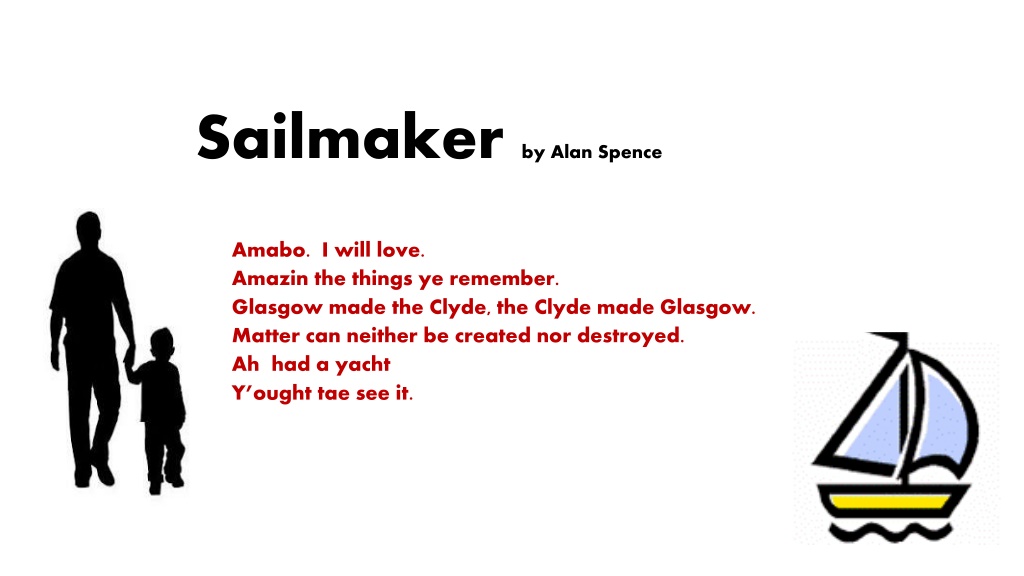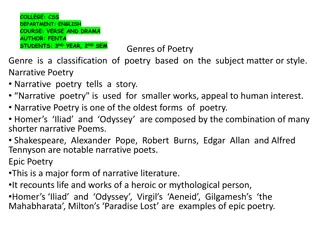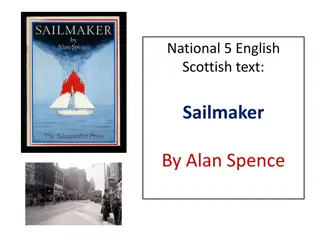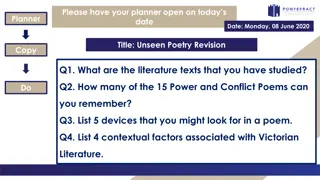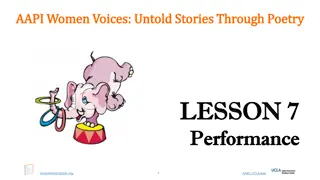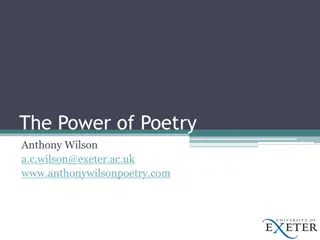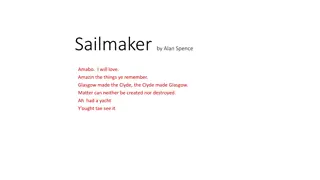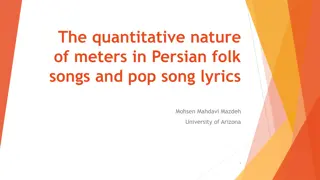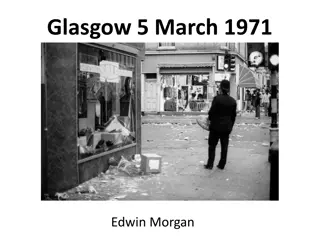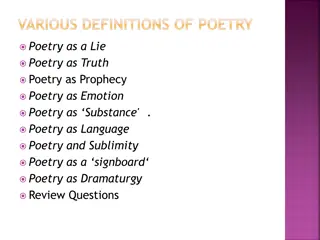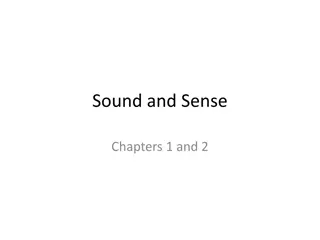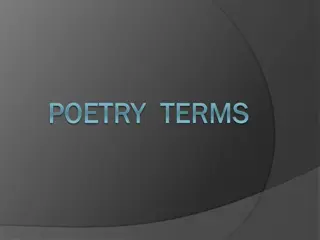Alan Spence: Exploring Glasgow Through Poetry and Plays
Alan Spence, a prolific author of poetry, novels, short stories, and plays, delves into the heart of Glasgow, drawing inspiration from his upbringing in the city. His major works such as "Sailmaker" reflect his personal experiences and the cultural divide in Glasgow, shaped by factors like the decline of the shipbuilding industry. Through his writing, Spence captures the essence of Glasgow, intertwining personal history with the city's rich tapestry.
Download Presentation

Please find below an Image/Link to download the presentation.
The content on the website is provided AS IS for your information and personal use only. It may not be sold, licensed, or shared on other websites without obtaining consent from the author. Download presentation by click this link. If you encounter any issues during the download, it is possible that the publisher has removed the file from their server.
E N D
Presentation Transcript
Sailmaker by Alan Spence Amabo. I will love. Amazin the things ye remember. Glasgow made the Clyde, the Clyde made Glasgow. Matter can neither be created nor destroyed. Ah had a yacht Y ought tae see it.
Learning Intentions: To introduce the text to those for whom it is unfamiliar; To underline the text s most obviously significant features; To think about teaching and learning in relation to the play; To understand the play in the context of the Critical Reading Scottish Text paper.
Alan Spence is an author of poetry, novels, short stories and plays He was born in Glasgow in 1947 and a lot of his work is based on the city and his own experiences of growing up here. Alan Spence is based in Edinburgh where he and his wife run the Sri Chinmoy Meditation Centre. Contemplative meditation is at the heart of his life and the perspective derived from this practice informs all of his work. Spence is a Professor in Creative Writing at the University of Aberdeen, where he is also the artistic director of the annual Word Festival.
Alan Spences major works includes Its Colours They Are Fine , The Magic Flute , Stone Garden , the plays Space Invaders and Sailmaker , and several books of poetry. He was brought up in Glasgow in a staunchly protestant culture, and Sailmaker certainly reflects this experience. Spence s mother died when he was eleven years old, and his father struggled to successfully navigate them through the subsequent years of their lives, both financially and emotionally. Sailmaker is a largely autobiographical play.
Spences Glasgow: Spence experienced Glasgow s cultural/religious divide and was brought up embedded in The Orange Order and Glasgow Rangers He experienced first-hand 1960 s poverty Spence has a qualified affection for his Glasgow childhood
The poverty was largely caused by Industrial Decline: Glasgow made the Clyde, the Clyde made Glasgow From 1870 until the start of the First World War Glasgow produced almost one fifth of the world's ocean-going ships. By the 1960 s only a few shipyards remained.
The Title of the play The title Sailmaker refers to the main character Alec s father s trade. For years, sailmakers had been fundamental contributors to the story of human endeavour, trade and civilization. The first sails were used in ancient Egypt and the Indian Ocean. Several thousands industrialisation of shipping during the 19thand early 20th centuries made sails unnecessary. This was a major departure in terms of economic and technological progress. of years later the
The obsolescence of sailmakers in general echoes of the obsolescence of Davie (Alec s father) in the play. A sense of huge loss is imparted to some extent through this comparison.
Plot Summary The play follows the lives of two main characters through approximately ten years of their lives. At the beginning of the drama we see the initial impact of the loss of Davie s wife and Alec s mother. Davie subsequently struggles to provide for his academically gifted son. A model ship becomes an important symbol in the play when Davie promises his son he will make sails for it. Despite promises to the contrary, he never does. As an implicit means of dealing with his mother s death Alec joins a number of religious organisations but they fail to fill the hole in his life. Eventually, learning seems to do this and Alec s rise as a student seems to correspond with Davie s decline as he loses his job largely through his own errors of judgement. At the end of the play Alec and Davie are in a state of poverty and they break up possessions in order to burn them to keep warm. The boat is symbolically and pathetically burned along with a number of other articles, and we are left with an ambiguous impression of completion, dissatisfaction, loss, acceptance and forgiveness.
Theme Theme Grief / Loss / Disappointment (The wooden boat) Departure / Change / Social mobility Acceptance / Healing Family relationships / Unconscious attachment / Conflict ( What is it I m looking for? It sailed in the fire, like a Viking longboat, out to sea in a blaze with the body of a dead chief. ) Poverty / Social class Timelessness in cycles of changes ( Matter can neither be created nor destroyed ) Immanence in the finite (See the story about the Buddhist monk burning the statue of the Buddha Ah think the idea was that everything s holy )
Characters Characters Alec Alan Spence, basically: he experiences the loss of his mother at an early age, an increasing awareness of the flaws of his father and separation from his roots (personally, socially, intellectually). Davie Alec s father: he is incapable of adapting to change and loss; he is a sail-maker (and therefore is highly skilled) to trade and is self-educated to a certain extent (has read Dickens ); he does not meet his responsibilities effectively and is a procrastinator (symbolised by the model yacht for which he never does make sails). Billy Davie s brother: he is a Big Orange head-banger according to Davie. He emanates casual bigotry. Yet, he does get things done, and can adapt to change. The fact he moves to Aberdeen and that his son becomes an Aberdeen supporter would suggest either that the prejudice he evinces will disintegrate through generational, economic and cultural change or that it will continue in a different form. Ian Davie s son: a simpler, less intellectual lad than Alec, he sees a chib where Alec sees a marlinspike ; he associates the intellect and higher social status with a negative perception of homosexuality. He will follow in his father s trade painting and will move away from Glasgow.
Symbolism Students could mind-map these symbols, explaining them and linking them with characters and motifs (the sea (its wonders, adventure, holy journeys, human intrepidity )) The yacht The broken mirror The holy medal The Star of the Sea The shell The sail-making tools Davie s furniture Songs: Last Train to San Fernando , Red Sails in the Sunset and My Generation
Structure The play has a fairly regular dramatic structure The exposition introduces the characters, the situation, the atmosphere and the central symbol; it depicts the initial reaction to the death of the mother, the hope attached to the model ship and the world of ordinary poverty. Some of the stylistic / dramatic devices: Alec s thrice recounted reaction to the news of his mother s death, as if searching for some kind of unified understanding or memory of the traumatic event; this sense of fragmentation is prevalent in the play and is recalled when Alec says of his dad s mirror at the beginning of Act 2 Look at it! There s a big crack doon the middle Canny get a good look at yerself . Sound and music are important in the play and the atmosphere of grief is accentuated at the beginning by the solitary boy who repeatedly plays two notes on the mouth organ. This is reinforced by the author s use of repetition and by the sense of ordinary decay and damage in the setting. The symbol of the model yacht is introduced near the beginning of the play, and Davie s pun Ah had a yacht. Y oughtto see it. is introduced. There is irony in Davie associating the homophones yacht (the model ship) and y ought (moral responsibility) given that he does not keep his word to mend the model (an object which may later be interpreted as a symbol for Alec s grief / loss). Ian s words Put it in the canal. Ye can all see it. are repeated by Davie at the end of the play and their significance is emphasised.
Structure continued The turning point find parts of the text that for you represent the turning point in the play (see pages 27-30). In what ways is it a turning point in the lives of the characters / the dramatic structure of the play?
Structure continued Climax of the action - the father/son conflict and the symbolic fire in Act 2 Resolution The symbolic burning of the boat
English Critical Reading: Section 2 - The Scottish Text Example For the purposes of this example, we are going to use the ending of the play as our selected passage. The passage begins at DAVIE: God. MA auld sailmakin tools. and ends with (Tape: Fats Domino, Red Sails in the Sunset) .
20 marks in total 1. How do Davie s words between lines 1-23 develop tone and mood in the scene? (2) With close reference to the text, show how the playwright reveals tension in relation to the possibility of Alec leaving home. (2) With reference to the passage selected, discuss the ways in which the burning of the following objects is significant: a) Davie s tools (2) b) The furniture (2) 4. How does the playwright develop the dramatic impact of the burning of the yacht through structure and imagery? (4) 5. Symbolism is an important technique employed throughout the play. With reference to the yacht (and any other symbolic feature) discuss the ways in which symbolism strengthens your understanding of the play as a whole. (8) 2. 3.
Now write a set of critical reading questions for either the opening or the turning point of the play Try to give students the chance to demonstrate their skills in commenting upon some of the following: word choice tone mood/atmosphere structure imagery tension dramatic impact symbolism ideas theme character development
